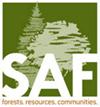Life-Cycle Greenhouse Gas Emissions from Forest Bioenergy Production at Combined Heat and Power Projects in Nova Scotia, Canada
IF 1.5
4区 农林科学
Q2 FORESTRY
引用次数: 0
Abstract
Forest bioenergy production can represent a renewable energy supply while benefiting the forest sector. However, greenhouse gas (GHG) reductions are often not immediate. The point of carbon parity where bioenergy starts delivering GHG benefits may be years to decades in the future. This study examined the life-cycle emissions associated with bioenergy production at combined heat-and-power (CHP) projects in Nova Scotia, Canada. We examined the effects and sensitivities of different feedstock mixes of chips from harvested roundwood and mill residues, the implementation of intensive and extensive silviculture strategies, and different market/supply-chain assumptions around additionality and product substitution. We found contrasting GHG outcomes for bioenergy, depending largely on additionality assumptions and biomass type. When primary biomass (roundwood) was used as the feedstock type, carbon parity was achieved within four to nine years when pulp and paper products were substituted, whereas carbon parity was achieved in 86–100 years or longer when biomass harvests were additional. Net GHG benefits were achieved in 10 years with the use of secondary biomass (mill residues) as the bioenergy feedstock, although they were delayed when at lower energy conversion efficiencies. Adoption of more intensive silvicultural practices (plantations) reduced the time to carbon parity because of increased yields, although uncertainties in long-term soil carbon storage exist. Study Implications: Our analysis shows that the use of forest biomass in local CHP facilities can deliver GHG benefits in the short term but there is substantial variability. Carbon parity times were the longest with the use of additional primary biomass feedstocks (i.e., roundwood) but were substantially reduced when biomass harvests substituted harvests for pulp and paper products and when secondary biomass (i.e., mill residues) was used. This study highlights the nuance of different forest management dimensions (e.g., silviculture) while also presenting novel findings on the importance of assumptions around biomass harvesting being additional to current practices or a substitution for declines in traditional forest products.加拿大新斯科舍省热电联产项目森林生物能源生产生命周期温室气体排放
森林生物能源生产可以代表一种可再生能源供应,同时使森林部门受益。然而,温室气体(GHG)的减少往往不是立竿见影的。生物能源开始产生温室气体效益的碳平价点可能是未来几年到几十年的事情。本研究调查了加拿大新斯科舍省热电联产(CHP)项目与生物能源生产相关的生命周期排放。我们研究了不同原料混合物的影响和敏感性,包括收获的圆木和磨渣,集约化和粗放化造林战略的实施,以及围绕附加性和产品替代的不同市场/供应链假设。我们发现,生物能源的温室气体排放结果差异很大,主要取决于附加性假设和生物质类型。当使用初级生物质(圆木)作为原料类型时,当纸浆和纸制品被取代时,碳平价在4到9年内实现,而当生物质收获额外时,碳平价在86-100年或更长时间内实现。使用二次生物质(磨渣)作为生物能源原料,在10年内实现了净温室气体效益,尽管在较低的能量转换效率下,它们被推迟了。尽管长期土壤碳储量存在不确定性,但由于产量增加,采用更集约化的造林(人工林)减少了达到碳平价的时间。研究意义:我们的分析表明,在当地热电联产设施中使用森林生物质可以在短期内带来温室气体效益,但存在很大的可变性。使用额外的初级生物质原料(即圆木)时,碳平价时间最长,但当生物质收获取代纸浆和纸制品的收获以及使用次级生物质(即磨坊残留物)时,碳平价时间大大减少。这项研究突出了不同森林管理层面(例如,造林)的细微差别,同时也提出了关于生物量采伐是当前做法的补充或替代传统森林产品下降的假设的重要性的新发现。
本文章由计算机程序翻译,如有差异,请以英文原文为准。
求助全文
约1分钟内获得全文
求助全文
来源期刊

Forest Science
农林科学-林学
CiteScore
2.80
自引率
7.10%
发文量
45
审稿时长
3 months
期刊介绍:
Forest Science is a peer-reviewed journal publishing fundamental and applied research that explores all aspects of natural and social sciences as they apply to the function and management of the forested ecosystems of the world. Topics include silviculture, forest management, biometrics, economics, entomology & pathology, fire & fuels management, forest ecology, genetics & tree improvement, geospatial technologies, harvesting & utilization, landscape ecology, operations research, forest policy, physiology, recreation, social sciences, soils & hydrology, and wildlife management.
Forest Science is published bimonthly in February, April, June, August, October, and December.
 求助内容:
求助内容: 应助结果提醒方式:
应助结果提醒方式:


